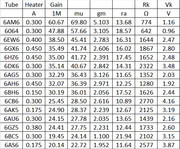I was shocked recently by the price of common tubes (12AX7 ECC83 etc), even the Chinese versions are very expensive compared to what they used to cost.
The law of supply and demand is one thing, but blind prejudice is another. This spurred me to start an experiment which I had been meaning to do for some time. I set up an experiment to test my collection of B7G pentodes connected as triodes.
In order to compare like-with-like, I fixed the supply voltage at 250V and the anode/plate voltage at 100V with the anode resistor at 100k so they all took 1.5mA, which is a good ballpark current. I adjusted the cathode resistor to achieve this.
I fixed the input voltage at 100mV @ 1kHz and then measured the output with no load and then with 1M. With a good DVM the load can be taken as almost infinite (10M) with a 1M load in parallel with the 100k RA, the load becomes 90.909k.
The standard gain equations can be used to determine the tubes parameters.
Gain1= mu x RA/ ra + RA and Gain2= mu x RL/ ra +RL
Re-arranging the equations we get:-
mu = (Gain1 x ra + RA)/ RA and mu= (Gain2 x ra + RL)/RL
As they both equal each other we can solve for ra by treating them as simultaneous equations.
When we have ra, we just put that back into the first equation to find mu. gm is then mu/ra.
I put all the equations and data into Excel to make life easier and the results are shown below.

The results are arranged in descending mu order and they show that it's possible to achieve gains from an ECC83/12AX7 level through to an ECC82/12AU7 and everything in between. I am not saying that any of the tubes were set up in their optimum operating points, rather it was meant to show the relative differences between them. These radio frequency pentodes sell for $3-$4 apiece and they come in a useful range of heater currents too. I would encourage every tube builder on GroupDIY not to mindlessly follow the herd but to experiment with the vast number of available radio and TV tubes sitting on the shelves in tube shops. I haven't even mentioned the B9A range!
Best
DaveP
The law of supply and demand is one thing, but blind prejudice is another. This spurred me to start an experiment which I had been meaning to do for some time. I set up an experiment to test my collection of B7G pentodes connected as triodes.
In order to compare like-with-like, I fixed the supply voltage at 250V and the anode/plate voltage at 100V with the anode resistor at 100k so they all took 1.5mA, which is a good ballpark current. I adjusted the cathode resistor to achieve this.
I fixed the input voltage at 100mV @ 1kHz and then measured the output with no load and then with 1M. With a good DVM the load can be taken as almost infinite (10M) with a 1M load in parallel with the 100k RA, the load becomes 90.909k.
The standard gain equations can be used to determine the tubes parameters.
Gain1= mu x RA/ ra + RA and Gain2= mu x RL/ ra +RL
Re-arranging the equations we get:-
mu = (Gain1 x ra + RA)/ RA and mu= (Gain2 x ra + RL)/RL
As they both equal each other we can solve for ra by treating them as simultaneous equations.
When we have ra, we just put that back into the first equation to find mu. gm is then mu/ra.
I put all the equations and data into Excel to make life easier and the results are shown below.

The results are arranged in descending mu order and they show that it's possible to achieve gains from an ECC83/12AX7 level through to an ECC82/12AU7 and everything in between. I am not saying that any of the tubes were set up in their optimum operating points, rather it was meant to show the relative differences between them. These radio frequency pentodes sell for $3-$4 apiece and they come in a useful range of heater currents too. I would encourage every tube builder on GroupDIY not to mindlessly follow the herd but to experiment with the vast number of available radio and TV tubes sitting on the shelves in tube shops. I haven't even mentioned the B9A range!
Best
DaveP


